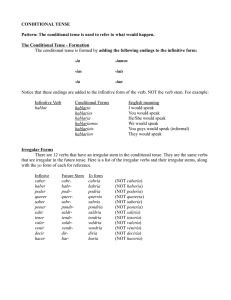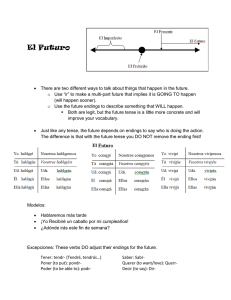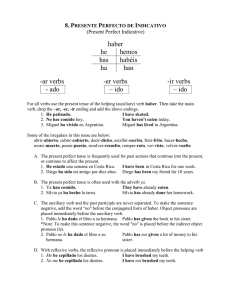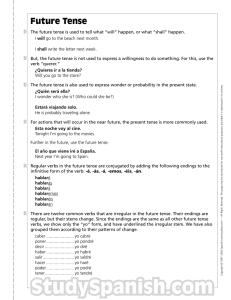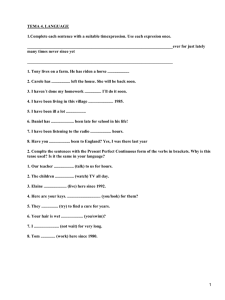Page 1 of 5 Spanish 3 - Unit 2, Lesson 5 Patterns Study
Anuncio
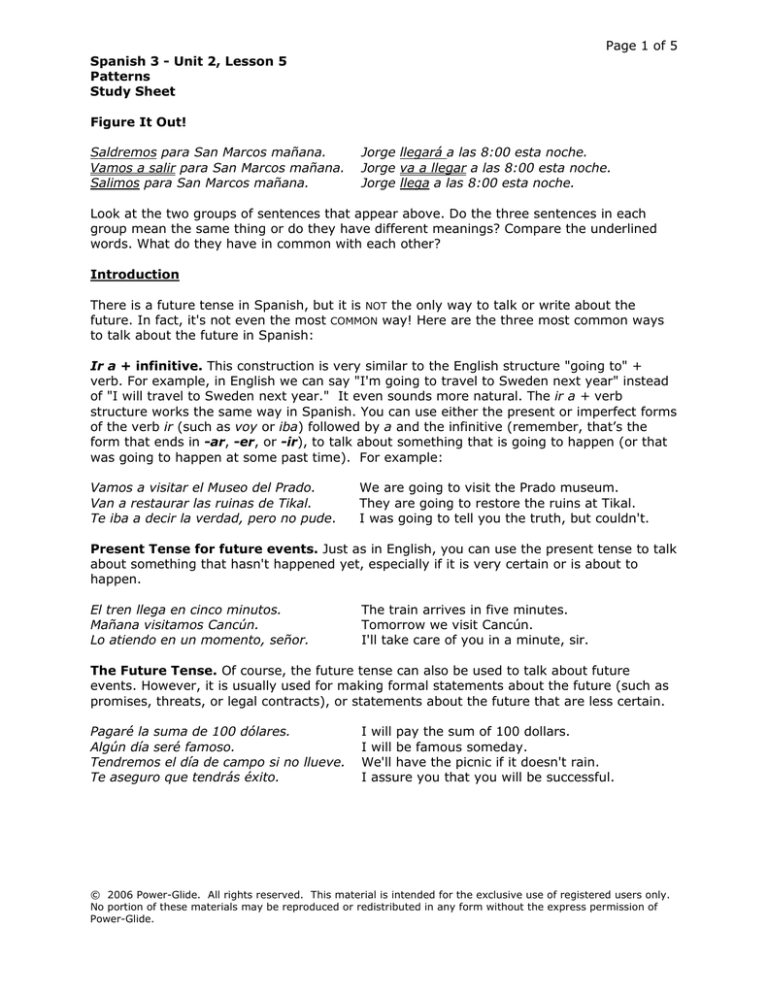
Page 1 of 5 Spanish 3 - Unit 2, Lesson 5 Patterns Study Sheet Figure It Out! Saldremos para San Marcos mañana. Vamos a salir para San Marcos mañana. Salimos para San Marcos mañana. Jorge llegará a las 8:00 esta noche. Jorge va a llegar a las 8:00 esta noche. Jorge llega a las 8:00 esta noche. Look at the two groups of sentences that appear above. Do the three sentences in each group mean the same thing or do they have different meanings? Compare the underlined words. What do they have in common with each other? Introduction There is a future tense in Spanish, but it is NOT the only way to talk or write about the future. In fact, it's not even the most COMMON way! Here are the three most common ways to talk about the future in Spanish: Ir a + infinitive. This construction is very similar to the English structure "going to" + verb. For example, in English we can say "I'm going to travel to Sweden next year" instead of "I will travel to Sweden next year." It even sounds more natural. The ir a + verb structure works the same way in Spanish. You can use either the present or imperfect forms of the verb ir (such as voy or iba) followed by a and the infinitive (remember, that’s the form that ends in -ar, -er, or -ir), to talk about something that is going to happen (or that was going to happen at some past time). For example: Vamos a visitar el Museo del Prado. Van a restaurar las ruinas de Tikal. Te iba a decir la verdad, pero no pude. We are going to visit the Prado museum. They are going to restore the ruins at Tikal. I was going to tell you the truth, but couldn't. Present Tense for future events. Just as in English, you can use the present tense to talk about something that hasn't happened yet, especially if it is very certain or is about to happen. El tren llega en cinco minutos. Mañana visitamos Cancún. Lo atiendo en un momento, señor. The train arrives in five minutes. Tomorrow we visit Cancún. I'll take care of you in a minute, sir. The Future Tense. Of course, the future tense can also be used to talk about future events. However, it is usually used for making formal statements about the future (such as promises, threats, or legal contracts), or statements about the future that are less certain. Pagaré la suma de 100 dólares. Algún día seré famoso. Tendremos el día de campo si no llueve. Te aseguro que tendrás éxito. I will pay the sum of 100 dollars. I will be famous someday. We'll have the picnic if it doesn't rain. I assure you that you will be successful. © 2006 Power-Glide. All rights reserved. This material is intended for the exclusive use of registered users only. No portion of these materials may be reproduced or redistributed in any form without the express permission of Power-Glide. Page 2 of 5 Spanish 3 - Unit 2, Lesson 5 Patterns Study Sheet Formation of the Future Tense - Regular For most verbs, the future tense is very simple to form. You just add a certain ending to the infinitive of the verb. There is no difference between the –ar, -er, and –ir verbs. The endings are shown in the table below with the verb hablar. REGULAR FORMATION OF THE FUTURE TENSE STEM + ENDING FUTURE VERB FORM (yo) hablar + é hablaré (tú) hablar + ás hablarás (él, ella, usted) hablar + á hablará (nosotros) hablar + emos hablaremos (vosotros) hablar + éis hablaréis (ellos, ellas, ustedes) hablarán hablar + án Formation of the Future Tense - Irregular Spanish has 12 verbs that don't follow the regular rules for forming the future tense. The six standard endings are the same for these verbs, but the roots change slightly. They are shown in the following table, which gives only the yo (–é) form in order to keep things simple. Of course, you can put any of the six endings on future tense verbs, depending on the subject (yo, tú, él, etc.). INFINITIVE VERB caber decir haber hacer poder poner querer saber salir tener valer venir IRREGULAR FUTURE TENSE VERBS STEM FORMATION cabrdirhabrharpodrpondrquerrsabrsaldrtendrvaldrvendr- cabr– + –é dir– + –é habr– + –é har– + –é podr– + –é pondr– + –é querr– + –é sabr– + –é saldr– + –é tendr– + –é valdr– + –é vendr– + –é FUTURE TENSE (FIRST PERSON SINGULAR) cabré diré habré haré podré pondré querré sabré saldré tendré valdré vendré © 2006 Power-Glide. All rights reserved. This material is intended for the exclusive use of registered users only. No portion of these materials may be reproduced or redistributed in any form without the express permission of Power-Glide. Page 3 of 5 Spanish 3 - Unit 2, Lesson 5 Patterns Study Sheet Other Uses of the Future Tense The Spanish future tense has two other important uses: to express speculation or "wondering" about something, and to give emphatic commands. Speculative use of the Future Tense. The following examples show how the future tense can be used in Spanish to refer to things that are uncertain: ¿Dónde habrá un poco de harina? Ese hombre tendrá unos cincuenta años. Habrán comido demasiado. I wonder where some flour is. That man is probably about fifty years old. They've probably eaten too much. Emphatic commands. In addition to the regular command forms of Spanish verbs, the future tense can be used to give commands with greater emphasis or sharpness: ¡Te quedarás aquí hasta que yo regrese! No matarás. Stay here until I come back! Thou shalt not kill. Summary You don't have to use the future tense to talk about things that are going to happen. And when you do use the future tense, sometimes it doesn't even refer to the future! There are other ways to talk or write about the future (using the ir a + infinitive construction or the simple present tense). In addition, the future tense has some other special uses in Spanish, including expressing suppositions and speculation, and giving emphatic, formal commands. © 2006 Power-Glide. All rights reserved. This material is intended for the exclusive use of registered users only. No portion of these materials may be reproduced or redistributed in any form without the express permission of Power-Glide. Spanish 3 - Unit 2, Lesson 5 Patterns Study Sheet Page 4 of 5 Practice Questions A. Paragraph Completion: Future Complete the following letter twice. The first time, fill in the blanks with future tense verbs. The second time, fill them in with the “ir a + verb” form of the future. Querida mamá, ¿Cómo estás? Esta es una pequeña nota que te escribo para que sepas lo que _______ (pasar) cuando yo te llegue a recoger al aeropuerto. Primero, (yo) _______ (llegar) a las 7:00 de la tarde. Es lo más temprano que puedo llegar. Te ________ (recoger) del aeropuerto y luego tú y yo _______ (ir) a comer a un restaurante. Luego nos ________ (venir) para la casa, donde tu cama ya ______ (estar) hecha para que puedas descansar. Estoy ansiosa por verte. Cariños, Tu nena B. Sentence Completion: Future Complete the following sentences with the correct form of the future tense. 1. 2. 3. 4. 5. ¿En qué año _______ (tener) tú 42 años? Yo le _____ (dar) la propina al camarero. Nosotros _____ (tomar) el bus a Lima mañana por la mañana. Mi vecino me _____ (ayudar) con mi tarea escolar esta noche. ¿_____ (seguir) Ud. esta dieta especial? C. Verb Changes: Future Look at each verb form and change it to the corresponding future tense. Keep the same person and number. For example, if it’s a yo verb, make it a yo verb in the future tense. If it’s an ellos verb, make it an ellos verb in the future tense, and so on. 1. 2. 3. 4. 5. vivió corren salieron amamos consigues _________________ _________________ _________________ _________________ _________________ D. Sentence Conversion: Future Convert the following sentences into the correct future tense from the ir a + infinitive. 1. Si Pepe no duerme bien, va a enfermarse. _________________________________________________________________________ 2. Mañana vamos a nadar. _________________________________________________________________________ 3. Nosotros vamos a trabajar mucho. _________________________________________________________________________ © 2006 Power-Glide. All rights reserved. This material is intended for the exclusive use of registered users only. No portion of these materials may be reproduced or redistributed in any form without the express permission of Power-Glide. Spanish 3 - Unit 2, Lesson 5 Patterns Study Sheet Page 5 of 5 4. No voy a poder llegar. _________________________________________________________________________ 5. Los turistas van a subir la pirámide. _________________________________________________________________________ E. Sentence Translation: Future Translate the following sentences into Spanish. 1. Tomorrow we will eat late. _________________________________________________________________________ 2. Who will come with you? _________________________________________________________________________ 3. What song will we sing? _________________________________________________________________________ F. Writing Exercise: Future Write three original sentences in the future tense using vocabulary you have learned. 1. _______________________________________________________________________ 2. _______________________________________________________________________ 3. _______________________________________________________________________ © 2006 Power-Glide. All rights reserved. This material is intended for the exclusive use of registered users only. No portion of these materials may be reproduced or redistributed in any form without the express permission of Power-Glide.
